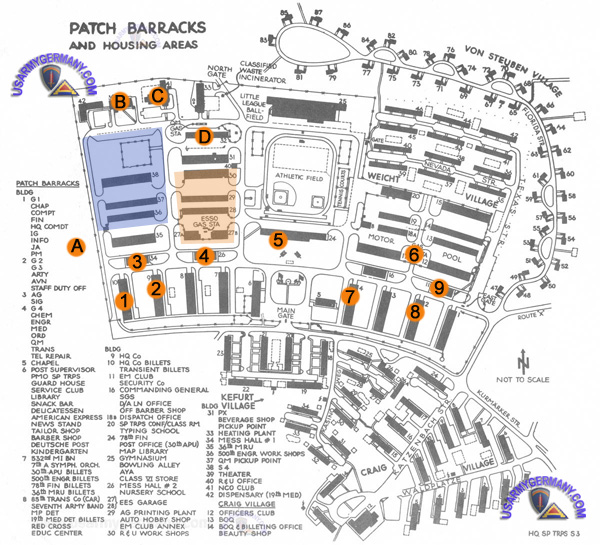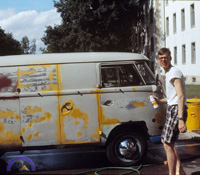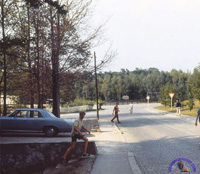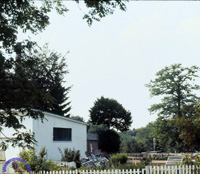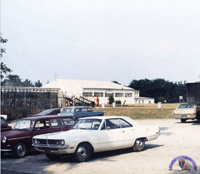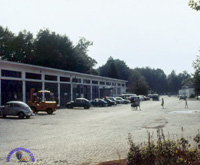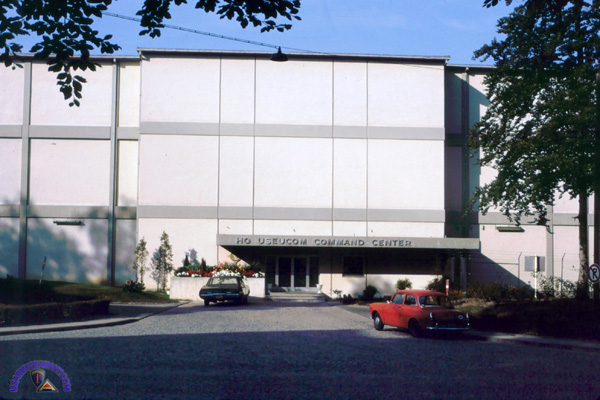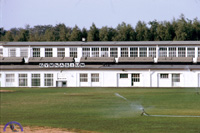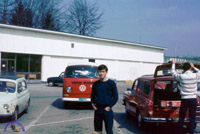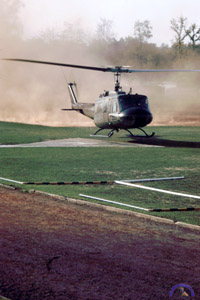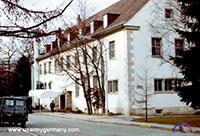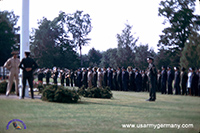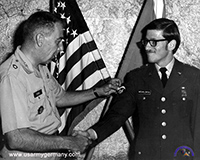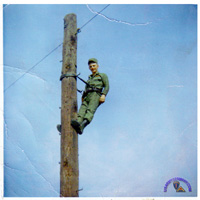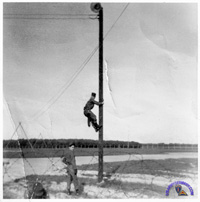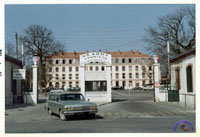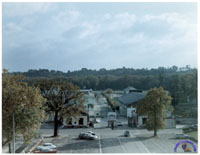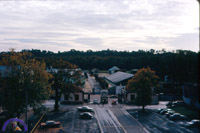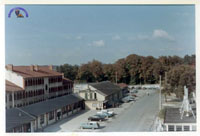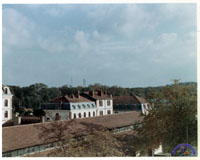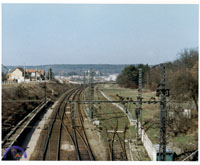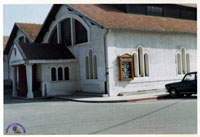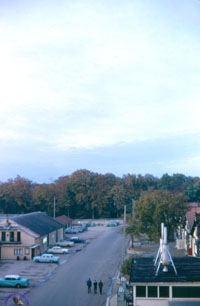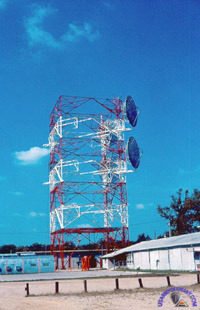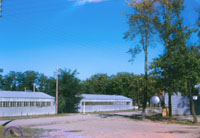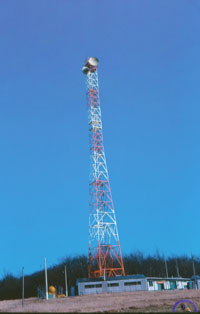| If you do
NOT see the Table of Contents frame to the left of this page, then Click here to open 'USArmyGermany' frameset |
|||||||||||||
106th Signal Group |
|||||||||||||
|
|
|||||||||||||
|
|||||||||||||
|
|
|||||||||||||
| Group History | |||||||||||||
| (Source: Official website of the 106th Signal Brigade, Fort Sam Houston, San Antonio, TX; accessed March 28, 2012) | |||||||||||||
| The 932d Signal Battalion was redesignated as Headquarters and Headquarters Detachment, 106th Signal Group 24 April 1963 as part of US Army Europe and officially activated on 12 August 1963 at Camp des Loges, France. The Group was later assigned to US Army Strategic Communications Command (USASCC) on 1 July 1964. The unit was relocated to Stuttgart, Germany in March, 1967 (as part of FRELOC) and |
|||||||||||||
| (Source: STARS & STRIPES, June 20, 1965) | |||||||||||||
| The 106th Signal Group in France, part of STRATCOM in Europe, (among other missions) operates and maintains relay stations in France in support of EUCOM and USAREUR. | |||||||||||||
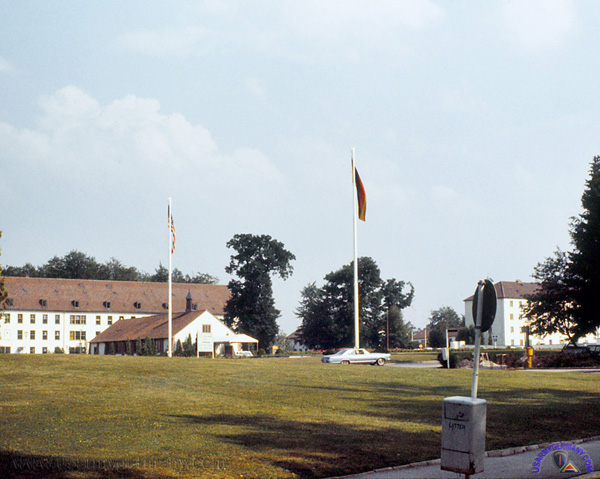 US and German flags near main entrance of Patch Barracks |
|||||||||||||
 106th Sig Gp barracks, Patch Barracks (1) |
|||||||||||||
| 1969 | |||||||||||||
| (Source: Email from Warner W. Johnston) | |||||||||||||
| 106th Signal Group, Patch Barracks, Vaihingen
You show the 106th Signal Group as being inactivated in Nov. 1967. However, I was in this signal Group as a Sp5 from May 1969 to Jan 1971. ADDITIONAL INFORMATON The proper name of the Patch Barracks signal company that was part of the 106th Signal Gp was not Hq Co but Sig Spt Co, USASTRATCOM, Sig Ctr USEUCOM, Cpt Patrick R. Forge SigC Commanding (29 Aug 69) On 27 Aug 70 I find 106th Sig Group USA STRATCOM USEUCOM John S. Wilbanks jr., 1LT, SigC Troop Commander The TDY to Garmisch, Germany for a Peace Conference involving John Eisenhower was the end of July, early August 1969 from the date on my military drivers exam. As mentioned earlier, the Patch Barracks contingent of the 106 worked at the Paris Peace talks from before May 1969 until 25 June 1970. I went to Paris on 26 Feb 1970. Also serving at Patch Barracks with me, as well as in Paris, but dates unknown were: Richard A. Sawyer SP5, Duane E. Weed SP5 and David M. Burger SSG I may find more pictures, and can probably fill some stuff in from memory, but that is going to be it on written records. HHD, 106th Sig Gp supplied communications to US EUCOM. We were also on call with the smaller companies for communications work at other locations as needed by Defense and State. I would say there were about 500 junior, E-6 and below, enlisted. HHD, as was the post commandant, only a structure for housing US EUCOM. Company A & B were to supply communications to Corps or larger groups in the field. I worked with one of them, I think B Co. which had a mobile comm unit in a tractor trailer. I would put the size (of the 106th Sig Gp) at a small battalion size. HQ was entirely fixed station, the A & B companies had more mobile equipment, or at least fixed equipment in large trucks. I don't remember the group commander, only the support company commander, but I was on nights the entire time I was there. We were set up around MOS, with an E-7 or E-8 as leader, E-6s and E-5s as shift supervisors. |
|||||||||||||
| This map is pretty close on to what I remember, the NCO/EM club became the Vice-Commanders HQ, the motor pool buildings to its north were torn down for Combat Command, the skeet range was to the west, off the map and the pistol range had the new NCO club. And now having looked at the command center from street level, it is the building there when I was. I was in it a lot, but actually worked across the street. No, 1 on the map: The three western most buildings, possibly four, were Barracks for HQ troops, I think Bldg 10 was AF, the next was 106 Sig Gp, and I think the one to its east was Army MP/Transport. The fourth building, to east, may have been the Navy/Marine EM Barracks or it could have been some place else. Army supplied Signal, MPs and Drivers attached to HQ not the post. All four services supplied HQ personnel in other positions, womens EW barracks and BOQ remembered in NE corner No 7 - Bldgs 1 - 4 : one contained the post library and one classrooms for U of M classes, although both could have been in the shorter building on the other side of the flag poles. No. 8 was the building I worked in. We were in the north end of the ground floor, all of the floor north of the entrance and half the basement under it. D - Rec Cen: Contained woodworking shop, photo lab and other such facilities for use of post personnel. |
|||||||||||||
|
|||||||||||||
| 1970 | |||||||||||||
| (Source: Email from Isaac Michalowski) | |||||||||||||
| I was stationed there (at the 106th Sig Gp) as well and was part of the AUTOSEVOCOM 32F20 Crypto Repair set up located I think in one of two building before the East gate. I was there around early 1970 till spring of 1972? I went to school at Ft Monmouth from fall of ’69 till spring 1970. 32F20 Crypto repair was a 52 week course along with a couple of weeks of Line conditioning school. |
|||||||||||||
|
|||||||||||||
| (Source: STARS & STRIPES, Aug 17, 1970) | |||||||||||||
| Col Edward A. Ford recently assumed command of the 106th Signal Support Group, STRATCOM-Europe. | |||||||||||||
| If you have more
information on the history or organization of the 106th Sig Gp, please
contact me |
|||||||||||||
|
|
|||||||||||||
| 246th Signal Company | |||||||||||||
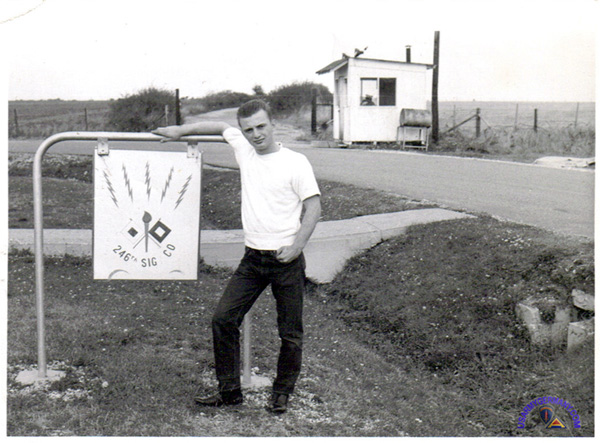 Joe Ricco next to company sign, near rear gate at Dreux AB, France |
|||||||||||||
The 296th Signal Company was redesignated 31 July 1963 as the 246th Signal Company. Activated 12 August 1963 in France. Inactivated 13 November 1967 in Germany. |
|||||||||||||
|
|||||||||||||
| 1963 | |||||||||||||
| (Source: Email from Joe Varga) | |||||||||||||
| Our mission was a field signal unit. We were controlled out of DA-DC. We came from three groups and locations to bring the company up to strength. My group came from Ft Bragg NC, one came from Ft Dietrich MD, and third came from Ft Gordon GA. We all went TDY to learn the MOS 72B10, Comm Center Specialists. Two groups were OJT and the third went to the school at Gordon. We were schooled onsite and tested daily. I was in the top seven of my group and ended up in live traffic at the comm center. Once in France all three groups were tested and the results were the two groups that went OJT knew more than the group that went to the signal school. Our group had 32 soldiers at Ft Bragg. When notified, we were to bug out and establish field communications for our signal group and NATO. I was in supply section, handled all functions, made supply runs to Evreux, Chartes, Camp De Loges. Estimated I drove over 100k miles with deuce and a half. Spent a lot of time maintaining my vehicles also. We had over 50 vehicles and a dozen or so commo vans. Had some great mechanics and eventually handled all company supply needs, property book, and laundry needs. We had MP's assigned to our Air Base that worked with the AP's. Although the MP's were not on our company authorization, I would give them gear and clear them for property turn in and release. MP's were great because the AP's were always after us. The Air Force had more freedom than than the Army. AF was always trying to fight with the Army. We had bed check, and functioned like a normal army unit in the field, had a duty driver, guard mount...we had an active commo van in a secure area in the motor pool. Passes were not a given, only 15% of unit allowed passes to Paris. We were the first company to establish communications on a NATO maneuvers at Fountainbleu. 246th Signal Company, Dreux, France Captain Donald S. Schadegg, Commander Following Names are from Promotion Orders: |
|||||||||||||
|
|
|||||||||||||
| 257th Signal Company | |||||||||||||
| 1962 | |||||||||||||
(Source: Email from Lawrence C. Collins, A Co, 62nd Sig Bn and 257th Sig Co, 1962) |
|||||||||||||
| I reported to Co. A of the 62nd Signal Battalion in October 1962. I was assigned as Communications Platoon Officer. The C.O. was Nicholas Mineo, now retired and living in Carlisle, Pa. The company was quartered in Quonset huts at a sub post of Harbord Barracks called "Maison Fort". The 69th also had a radio-carrier company located at Vassincourt, near Bar-le -Duc in Northern France and an aviation company located somewhere in central France. As I recall Orleans was the headquarters of USA COMZ and we were about 10 miles south of there. I was transferred to Camp des Loges to be C/O of the newly formed 257th Sig. Co. when the 69th rotated back to the states. I recall the vehicles and conex containers of gear were sent to Ft. Eustis but most of the personnel were dispersed to other units in USAREUR. Would like to hear from old SigC people. Lawrence C. Collins |
|||||||||||||
| 1964 | |||||||||||||
| (Source: Email from Joe Ricco) | |||||||||||||
| I was assigned to the 246th and 257th Signal Companies from Feb. 1964 till Oct 1967. Made the move to Patch Barracks. Was a cable splicer worked for a Sgt Herbert Dustman -- we called him Dusty. Also remember a Lt Collins as wire officer. Had a wire nco named Jim Tinsley who later worked for Ma Bell in Oakland and I was a installer for Western Electric. I remember a few names: Jessie Towsend, Chuck Seibold, Bob Branning, Claude Mitchell. We had 2 German Nationals in our company -- Muller and Al Udie. At the 257th Wire Platoon shared the barracks with the medics. One mean one named Sanchez. Was always at it with the MP's. Our armor stole some 45's and went AWOL. I worked at the officers club for a Major with a red face. |
|||||||||||||
1965 |
|||||||||||||
| (Source: Email from Jeff Grill) | |||||||||||||
My name is Jeff Grill and I arrived as a PFC at Camp des Loges, France on October 10, 1965. I was a 32F20 Fixed Ciphony Repairman assigned to the 257th Signal Service Company and worked in the AUTOSEVOCOM section of the Headquarters USEUCOM building. I was told that the barracks that we lived in were old stables, and I can believe that because of the layout, but for no other reason. Of course, if you had to be stationed somewhere, just outside of Paris at 19 years old was a dream. I stayed in the unit until September 1968 and was part of the move to Stuttgart, Germany in January, 1967. Thanks to the NCO’s in my section I was able to go from PFC to SSG in 19 months, as well as many of the people that I worked with. Some of the people I remember are: My apologies for those I have left out and for any mistakes or omissions in rank. After more than 50 years my memories for details sometimes fails. I can say without hesitation the time I spent in France and Germany were among the best in my life. |
|||||||||||||
| 293rd Signal Company | |||||||||||||
| 1963 | |||||||||||||
| (Source: Email from Don Rohrbaugh, B Co, 29th Sig Bn then 293rd Sig Co) | |||||||||||||
| I arrived at Caserne Lariboisiere in Fontainebleau in June 1963. Then it was known as Co. B, 29th Signal Battalion. Around September 1963 we changed to 293rd Signal Company, 106th Signal Group. To backtrack a little I left New York in early June 1963 on USS troop transport Simon B. Buckner and docked in Bremerhaven, Germany in mid June, and from there by train to Paris. My MOS was 71J20, "Military Pay Specialist", and I worked in the Personnel Office with other G.I.'s along with many French civilians from the area. Maybe some who were there would remember their names like Andrea Pichon, Simone, and Josie Ann. I think there were four detachments on base which were Hq. & Hq Co.; 14th Gen. Hosp.; 67th M.P. Co.; and the 293rd. The 543rd Engr. Co. were in Melun, France, which was near there, but we took care of their records. I had no signal or communication training in the States and therefore no particular job to do on field exercises. If I remember correctly they trucked me back to base to work in the morning. My job was to make any kind of pay changes to personnel such as upgrade or downgrade in rank, leave rations, and I think TDY pay and submit them for the following month's payroll. There were many walks my friends and I took down along the Seine and into town for a beer at an outside cafe. All in all it was a great experience and will never forget the people I was associated with. I rotated back to the States by air in late December 1965 to McGuire Air Force Base for discharge. |
|||||||||||||
| (Source: Email from Richard Dodson, 293rd Sig Co and 106th Sig Gp) | |||||||||||||
| I was a Platoon Leader with and later the Executive Officer
of the 293rd Signal Company at Kaserne Lariboisiere in
Fontainebleau. When we left France and moved to Germany,
I was reassigned to the 106th Signal Group at Patch Barracks.
As a matter of fact, I was the OIC of the Communication Control
Center that monitored/controlled the switch over of all Long-Haul
Communications supporting HQ EUCOM at Camp Des Loge (near
Paris), then Patch Barracks at Vaihingen, Germany. I later served as Assistant S-3 for the 106th Signal Group and it was my job to test all of the Communications supporting HQ EUCOM whenever it deployed to the field. I can remember making Secure calls to units throughout Europe and CONUS, including the Pentagon, “Cheyenne Mt., CO,” as well as Non-Secure calls on the AUTOVON system. One those exercises was conducted at Pruem (actually Prüm), Germany. If interested, I still keep in regular contact with the individual who was the Company Commander of the 293rd Signal Company, after it moved to Prüm. He also served with the 246th at Druex AFB, then was Co-OIC of the Communication Control Center at Patch Barracks during the switch-over of the Long-Haul Communications from Camp Des Loge to Patch Barracks. |
|||||||||||||
(Source: Email from Bob Gaudio) |
|||||||||||||
I came across your 5th Signal Command web site, and discovered a little bit of the history of my old Army unit, the 293rd Signal Company, part of the 106th Signal Group. I was a Tech Controller with the 293rd from March 1965 to June 1967, and was among those "booted" out of France in March 67. I was TDY a few times to the 257th, 246th Signal Companies, and the NATO segment outside of Paris and have copies of those orders. I do have copies of most of my orders, pay slips and other paper momentos (unit rosters) of that period of time. Here is a little background about my service with the 293rd Signal Company. The 293rd, along with the 246th and 257th Signal Company's were all part of the 106th Signal Group. The 257th operated the fixed communications center (minus microwave radio) at (HQ) USEUCOM, Camp Des Loges, France, and the 293rd along with the 246th served as mobile/fixed communications backup for the 257th. From time-to-time, the 293rd and 246th would participate in "field problems", by diverting existing land line telephone and teletype communications circuits, that terminated at the 257th Com Center, from strategic French PTT (the telephone company) central offices, and extended the circuits, via microwave radio to a remote temporary communications center. The 293rd provided the microwave radio, multiplex and technical control components, and the 246th provided the cryptographic and communications center components. All of the equipment was housed in 2½-ton and 5-ton tractor trailer combination vehicles. Portable gas powered electric generators, and mess facilities were all part of the package. The 293rd was based in Fontainebleau, France at the Caserne Lariboisiere, which was a old 4-floor French military barracks. Single Enlisted Men lived in the barracks, and married personal lived off post on the economy. One of the EM periodic duties was to be an "alert driver", which was to drive an assigned route, to alert those personnel living off post to assemble at the post for what ever reason. I believe we had a 4 hour ready to roll commitment. The 246th was based at Druex, France AFB, and had similar off hour duties. Our relations with the local French was OK, from a 19 year olds point of view. Downtown Fontainebleau was within easy walking distance, and Paris was a 1 hour train ride. Some people had vehicles, and never had problems getting around, etc. During the month of February 1967, the 293rd was ordered a permanent change of station to Pruem, Germany. Some of the unit was sent to Stuttgart, Germany. I'm not sure where the 246th went to, or what happened to the personnel from the 257th. Prior to my rotation back to the U.S. in June 1967, we didn't perform any "field problems" so I'm not sure what the new mission was after being asked to leave France. |
|||||||||||||
(Source: Email from Randy Shields, 293rd Sig Co, 1965-66 and 257th Sig Co, 1966-67) |
|||||||||||||
Served as a Tech. Controller with the 293rd Signal Company in France from Nov. 1965 through Nov. 1966, then assigned to 257th to set up forward communications at Patch Barracks until discharge Sept. 1967. I worked the temp. Tech. Control trailer and helped in the construction of the Tech. Control Facilites in the basement of one of the buildings at Patch Barracks. Field call sign for field unit PBK. Now work as a Senior Communication Engineer for American Electric Power. Randy Shields |
|||||||||||||
| (Source: Email from Earl Carter, 293rd Sig Co, 1966-67) | |||||||||||||
| I was a member of the 293rd Signal Company in Fontainebleau, France from Feb 2, 1966 through July 15, 1967. I was a 31M20 Radio Relay and Carrier Attendant and worked with VHF/UHF radio equipment. I worked very little with the carrier equipment. During my time in Fontainebleau I spent time in school in Lenggries, Germany, TDY in Orleans at Maison Fort, and TD in Verdun. Six operators and Sgt William Baker took radio trucks to Verdun and set up to take over communication links previously served by microwave equipment, which had been moved to Germany. We went there about Dec 1, 1966 and on Mar 15, 1967, went to Prüm, Germany, where the 293rd had already relocated. Once we left Fontainebleau in Dec we never went back. I was a draftee in the Army so I only spent 2 years active duty, but enjoyed it. I got to see a part of the world that I would have probably only seen in pictures. Since I had an electronic background before my Army days I have spent the better part of my working years with the Sperry Corporation, which later became UNISYS, as a computer technician, and the Raytheon Company. I have pictures that I took of the post in Fontainebleau if you would be interested in them. They being color photos from the 1960’s have faded a bit but are still pretty good. I still keep in touch with a friend in Coshocton, Ohio who was in the 293rd at the same time. |
|||||||||||||
|
|||||||||||||
|
|||||||||||||
| Related Links: |
|||||||||||||

